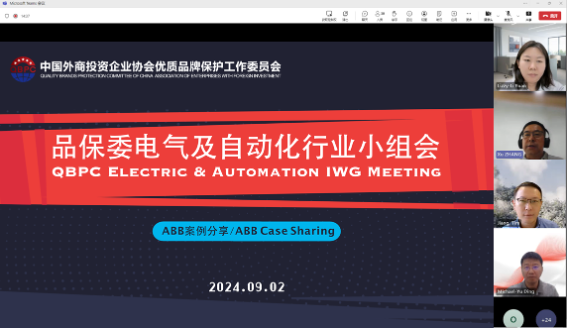On September 2, the QBPC Electric & Automation IWG (E&A IWG) successfully held a sharing meeting, inviting QBPC Chair Michael Ding (ABB), Lizzy Yuan (ABB), and Case Handling Lawyer Xu ZHANG to share the Criminal Case against Manufacture and Sale of Refurbished “ABB” Drives by LONG Et Al., which had been selected as one of QBPC 2023-2024 Annual Top Ten Cases. 25 representatives from 19 QBPC member companies participated in the event.

As a headache for the industrial products industry, second-hand refurbishment products created a general concern among IWG members. In the opening remarks, the E&A IWG Coordinator Tim Jiang said that it was complex to defend the rights in cases of second-hand refurbishment products, which put.the right holders at a loss. He hoped that the IWG members could fully understand the handling approaches and learn from the successful experience from the case.
ZHANG first briefly introduced the case background and summarized its highlights, such as continuous evidence collection by penetrating, effective communication with public security authorities and procuratorate organs, rigorous and efficient product identification procedures, and product disposal. Lizzy then deeply analyzed the experience of internal collaboration with the business departments from the perspective of the company's legal affairs. She said that the unification and implementation of the ideal procedure and division of labor mechanism with the business departments was critical for accurate test buy, prompt identification, and successful raid. In addition, strengthening the publicity of successful cases, improving product destruction procedures, and standardizing channel management were essential for further strengthening intellectual property protection. Next, ZHANG elaborated on the characterization and legal challenges of refurbishment products as well as discussing the role of trademark quality assurance and the function of distinguishing product origins in the protection of trademark exclusive rights, the definition of core components, and the methodology for dealing with the related issues.
Michael stated that no success would have been achieved without the resolution of specialized legal issues and the support of relevant departments within the company. In addition, right holders should be fully aware of the latest judicial and law enforcement developments, actively maintain communication with relevant authorities, and follow up on cases in a timely manner.
In the interactive session, participants and guest speakers had an exchange on the details of the case handling, including the seized products, the value assessment of refurbishment products, and seeking support from the business departments.
